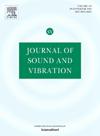Interpretable damage sensitive feature extraction for drive-by structural health monitoring using knowledge distillation-based deep learning
IF 4.3
2区 工程技术
Q1 ACOUSTICS
引用次数: 0
Abstract
Drive-by Structural Health Monitoring (SHM) has the potential to effectively monitor the health conditions of bridges within transportation networks at a low cost. However, how to extract damage features from the drive-by measurements that are sensitive to changes in structural conditions while being robust to variations in vehicle loading scenarios and operational conditions is still an open question. This paper leverages advanced deep learning and knowledge distillation techniques to extract reliable damage-sensitive features from drive-by measurements in a supervised manner. To accomplish this, the proposed deep learning network is trained using thousands of drive-by measurements collected under various conditions, including different vehicle speeds, weights, directions, and structural damage states. This study includes an analysis of the network's intermediate layer outputs, numerical results from a finite element (FE) model of the test bridge, and theoretical derivations to interpret the physical significance of the learned damage features. The knowledge gained from this deep learning network subsequently informs and guides the theoretical development of generally applicable damage-sensitive features for drive-by SHM. In particular, this research work evidences that, in future drive-by SHM studies, more attention should be paid to the low-frequency driving speed-related component, instead of the conventional methods that focus on separating and extracting damage features from the bridge modal vibration related component of the drive-by measurement.
基于知识提取的深度学习的可解释损伤敏感特征提取
驱动式结构健康监测(SHM)具有以低成本有效监测交通网络中桥梁健康状况的潜力。然而,如何从驾驶测量中提取对结构条件变化敏感的损伤特征,同时对车辆加载场景和操作条件的变化保持鲁棒性,仍然是一个悬而未决的问题。本文利用先进的深度学习和知识蒸馏技术,以监督的方式从驾驶测量中提取可靠的损伤敏感特征。为了实现这一目标,所提出的深度学习网络使用在各种条件下收集的数千个驾驶测量数据进行训练,包括不同的车辆速度、重量、方向和结构损坏状态。本研究包括对网络中间层输出的分析,测试桥梁的有限元模型的数值结果,以及解释学习损伤特征的物理意义的理论推导。从这个深度学习网络中获得的知识随后为驱动式SHM普遍适用的损伤敏感特征的理论发展提供了信息和指导。特别是,本研究表明,在未来的驱动SHM研究中,应更多地关注低频驱动速度相关分量,而不是传统的方法侧重于从驱动测量的桥梁模态振动相关分量中分离和提取损伤特征。
本文章由计算机程序翻译,如有差异,请以英文原文为准。
求助全文
约1分钟内获得全文
求助全文
来源期刊

Journal of Sound and Vibration
工程技术-工程:机械
CiteScore
9.10
自引率
10.60%
发文量
551
审稿时长
69 days
期刊介绍:
The Journal of Sound and Vibration (JSV) is an independent journal devoted to the prompt publication of original papers, both theoretical and experimental, that provide new information on any aspect of sound or vibration. There is an emphasis on fundamental work that has potential for practical application.
JSV was founded and operates on the premise that the subject of sound and vibration requires a journal that publishes papers of a high technical standard across the various subdisciplines, thus facilitating awareness of techniques and discoveries in one area that may be applicable in others.
 求助内容:
求助内容: 应助结果提醒方式:
应助结果提醒方式:


